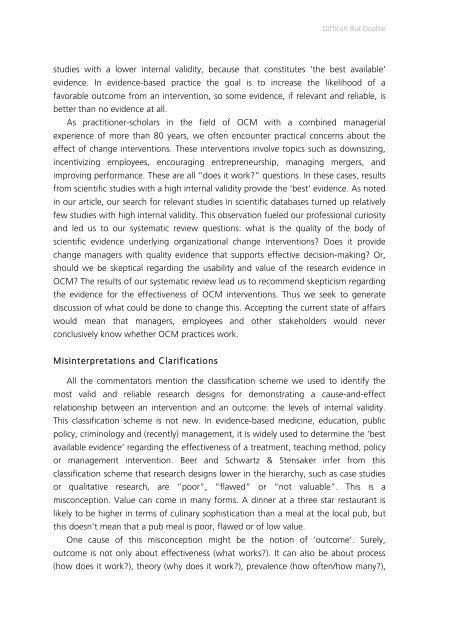In Search of Evidence
jqluvth
jqluvth
Create successful ePaper yourself
Turn your PDF publications into a flip-book with our unique Google optimized e-Paper software.
Difficult But Doable<br />
studies with a lower internal validity, because that constitutes ‘the best available’<br />
evidence. <strong>In</strong> evidence-based practice the goal is to increase the likelihood <strong>of</strong> a<br />
favorable outcome from an intervention, so some evidence, if relevant and reliable, is<br />
better than no evidence at all.<br />
As practitioner-scholars in the field <strong>of</strong> OCM with a combined managerial<br />
experience <strong>of</strong> more than 80 years, we <strong>of</strong>ten encounter practical concerns about the<br />
effect <strong>of</strong> change interventions. These interventions involve topics such as downsizing,<br />
incentivizing employees, encouraging entrepreneurship, managing mergers, and<br />
improving performance. These are all “does it work?” questions. <strong>In</strong> these cases, results<br />
from scientific studies with a high internal validity provide the ‘best’ evidence. As noted<br />
in our article, our search for relevant studies in scientific databases turned up relatively<br />
few studies with high internal validity. This observation fueled our pr<strong>of</strong>essional curiosity<br />
and led us to our systematic review questions: what is the quality <strong>of</strong> the body <strong>of</strong><br />
scientific evidence underlying organizational change interventions? Does it provide<br />
change managers with quality evidence that supports effective decision-making? Or,<br />
should we be skeptical regarding the usability and value <strong>of</strong> the research evidence in<br />
OCM? The results <strong>of</strong> our systematic review lead us to recommend skepticism regarding<br />
the evidence for the effectiveness <strong>of</strong> OCM interventions. Thus we seek to generate<br />
discussion <strong>of</strong> what could be done to change this. Accepting the current state <strong>of</strong> affairs<br />
would mean that managers, employees and other stakeholders would never<br />
conclusively know whether OCM practices work.<br />
Misinterpretations and Clarifications<br />
All the commentators mention the classification scheme we used to identify the<br />
most valid and reliable research designs for demonstrating a cause-and-effect<br />
relationship between an intervention and an outcome: the levels <strong>of</strong> internal validity.<br />
This classification scheme is not new. <strong>In</strong> evidence-based medicine, education, public<br />
policy, criminology and (recently) management, it is widely used to determine the ‘best<br />
available evidence’ regarding the effectiveness <strong>of</strong> a treatment, teaching method, policy<br />
or management intervention. Beer and Schwartz & Stensaker infer from this<br />
classification scheme that research designs lower in the hierarchy, such as case studies<br />
or qualitative research, are “poor”, “flawed” or “not valuable”. This is a<br />
misconception. Value can come in many forms. A dinner at a three star restaurant is<br />
likely to be higher in terms <strong>of</strong> culinary sophistication than a meal at the local pub, but<br />
this doesn’t mean that a pub meal is poor, flawed or <strong>of</strong> low value.<br />
One cause <strong>of</strong> this misconception might be the notion <strong>of</strong> ‘outcome’. Surely,<br />
outcome is not only about effectiveness (what works?). It can also be about process<br />
(how does it work?), theory (why does it work?), prevalence (how <strong>of</strong>ten/how many?),


